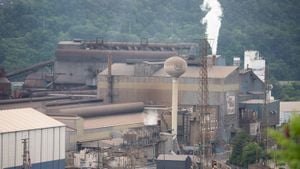Nuclear energy is stirring up renewed interest across the United States as technological advancements and changing energy demands fuel debates about its potential role in the future of energy production. The recent developments surrounding nuclear power, particularly highlighted by Microsoft and Constellation Energy’s plan to restart the Three Mile Island Unit 1 reactor by 2028, reflect this revival.
Three Mile Island, infamous for the worst nuclear accident in U.S. history back in 1979, has become emblematic of the new era of nuclear energy—Atomic Age 2.0, if you will. With the current plan to reactivate its undamaged Unit 1, this site signals both hope and hesitation about nuclear power’s rebirth.
The world’s urgent need for reliable and stable energy sources has brought nuclear back onto the forefront. What’s spurring this change? A combination of the booming artificial intelligence (AI) sector, energy demands from data centers, and the broader push to combat climate change have placed nuclear energy back on the radar of major corporations and government officials alike.
Microsoft’s partnership with Constellation will see the tech giant pay between $110 and $115 per megawatt-hour for electricity, which is more than double the average cost of standard power deals. This decision underlines the growing economic viability of nuclear power as energy consumption climbs, especially driven by AI applications and other technology sectors. Current projections show energy demand may double over the coming decade, paralleling the surge of data centers necessary to support AI functionality.
Big Tech firms like Microsoft, Google, and Amazon are increasingly leaning toward nuclear as they grapple with the high electricity demands of their operations. Utilities, previously fixated on renewable sources like solar and wind, are now ramping up their discussions surrounding nuclear. A noteworthy shift has occurred with Entergy, which went from mentioning nuclear zero times during its last quarterly call to discussing it 22 times during recent earnings updates.
This strategic pivot suggests nuclear energy is no longer just seen through the lens of its past challenges—like the accidents of Chernobyl and Fukushima. Instead, there is growing recognition of its potential as a low-carbon alternative capable of providing the baseload power generation necessary to stabilize grids powered primarily by intermittent renewable sources.
While the potential for small modular reactors (SMRs) has emerged as part of this renewed interest, skepticism remains. Many industry experts argue they may not come online soon enough to address the immediate energy demands. Announcements about SMR developments are often vague, and contrary to popular belief, solar and geothermal technologies are currently proving to be more cost-effective and quicker to deploy than traditional nuclear power solutions.
Despite these challenges, the push for nuclear isn't merely rooted in technological advancements but also is influenced by shifting climate change policies. With 28 countries pledging to triple their nuclear capacities by 2050, there is significant momentum building behind this energy source as economies grapple with the need for clean energy solutions.
Support for nuclear power at global climate discussions suggests the world may be turning the corner on its historical reservation about nuclear energy. The World Nuclear Association’s director, Dr. Sama Bilbao y Leon, noted how discussions around nuclear have changed dramatically over the years—what once invited hostility now garners more openness and support.
The economic shift backing nuclear energy, coupled with the external pressures from climate change, environment concerns, and energy demands from new technologies, has nurtured this revival. Policymakers are being urged to streamline processes governing nuclear energy to facilitate quicker deployment, reduce regulatory hurdles, and offer clearer guidelines for nuclear projects.
Another compelling piece to the nuclear renaissance is cost. Historically, the high costs and prolonged timelines associated with building new reactors have deterred investment and development. Proponents argue SMRs could transcend these challenges by being simpler and less expensive due to their factory-built nature and smaller size.
This looks promising on paper, but many still question the practicality of SMRs and whether they can contribute meaningfully to the energy grid by 2030.
The revival of interest encompasses both private investors and large corporations, intent on establishing nuclear energy as part of their sustainability and energy strategies. This momentum feels different, characterized by genuine interest amid previous skepticism, and is driven by the necessity to balance economic growth with environmental responsibility.
Analysts warn to temper expectations, cautioning against the hype surrounding nuclear’s revival. Although the restart of facilities like TMI and discussions of newer technologies indicate movement toward embracing nuclear, the full-scale integration of nuclear energy as a primary energy source will require patience, investment, and innovation.
The energy narrative is sure to evolve as time progresses. Today’s developments surrounding nuclear power mark merely the inception of what could potentially be both quantitative and qualitative changes within the energy sector. That said, achieving the level of transformation envisioned will depend primarily on how regulatory frameworks respond to the calls for urgency and efficiency.
Given the intertwining of energy demands and the urgency of climate change, the return of nuclear energy to the energy conversation is not just historical—it could very well be revolutionary if all parties successfully navigate the complex web of challenges and potential opportunities.



